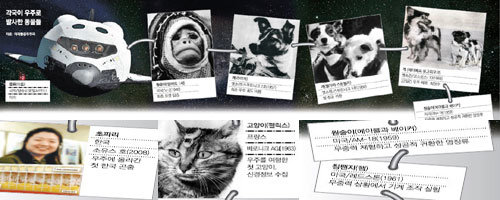Animals in Space

○ Fruit flies: the first-ever space animal
In the initial stage of space development, scientists used animals to determine humans survivability in space. The first animals sent into space were fruit flies. In 1947, the United States sent them on a V2 rocket it had obtained from Nazi Germany shortly after World War II. The purpose of the experiment was to explore the effects of radiation exposure in space.
In 1948, the United States sent two Rhesus monkeys, Albert and Albert II, aboard V2 into space. Albert II successfully flied 133 kilometers but died on impact after a parachute failure. In 1951, a monkey named Yorick became the first monkey to live through a space travel along with 11 mice aboard the same rocket.
Unlike the United States, which mainly used monkeys and mice, the then Soviet Union chose dogs on the belief that dogs are better suited to spaceflight since they are less picky than monkeys.
In 1951, the Soviet Union launched an R-1 rocket, carrying two dogs. Although they failed to fly into the space orbit, they were recorded as the first dogs to survive spaceflight. The first animal in orbit was a dog named Laika, launched aboard the Soviet Sputnik 2 spacecraft in 1957. At least 10 other dogs were launched into space before Yuri Gagarin became the first human in space in 1961. But most of the dogs died in launching from or returning to the earth.
○ Significant sacrifice for human dreams
Scientists gained confidence from successful experiments and became interested in safe return from and activities in space. A U.S. Navy-trained squirrel monkey named "Gordo" successfully reached the space orbit on board an inter-continental ballistic missile in 1958. Returning to the earth, Gordo endured weight 10 times heavier than its body weight, showing the possibility of safe return of a human astronaut. However, the monkey died of shock in the final landing process. Monkeys "Able" and "Baker" launched the same year became the first monkeys to survive spaceflight, which flied up to the altitude of 450 kilometers.
Ham the Chimp, the hero of the film Space Chimps, was launched on board a Redstone rocket in 1961. His mission was to handle a mock dashboard installed in the spacecraft. He demonstrated that a human astronaut is able to perform a task of handling a complex dashboard in zero gravity.
Some animals stayed in orbit for an extended period. Two Russian dogs, Veterok and Ugolyok, launched in 1966, spent 22 days in orbit before landing. This spaceflight of record-breaking duration was not surpassed by humans until 1974.
○ Korea`s first animal in space
In the 1960s and 70s, a variety of animals were sent into space. In 1961, the Soviet Union launched Vostok 3A along with mice, guinea pigs and frogs. France flew Felix the Cat into space with electrodes implanted into its head to measure neural impulses. Afterwards, spiders, snails, carp, minnows, cod fish, quails and gypsy moth were launched.
In Asia, whereas China flew guinea pigs in 1990 and Japan launched a species of amphibia into space in 1995, Korea has not sent any animal into space aboard a rocket developed on its own. Only animal that it has sent is 1,000 fruit flies that Korea`s first astronaut Yi So-yeon carried to the International Space Station in April this year. About 600 of them successfully returned to the earth along with Yi on April 19. Scientists will utilize the experiment in studying physical changes that can happen to humans in long-term spaceflight.
kunta@donga.com





![‘치매머니 사냥’ 요양원도 휩쓸어…통장 텅 비어 간식비도 못내 [히어로콘텐츠/헌트③-上]](https://dimg.donga.com/c/138/175/90/1/wps/NEWS/IMAGE/2025/12/16/132980393.1.jpg)

